Additive Nano-Lithography with Focused Soft X-rays: Basics, Challenges, and Opportunities
Abstract
1. Introduction
2. Things to Know about STXM and X-ray Induced Radiation Damage
3. Current FXBID Set-Up
4. What We Have Already Learned About FXBID
- Co(CO)3NO: Co L3-edge (~780 eV), O K-edge (~530 eV), N K-edge (~395 eV),
- Fe(CO)5: Fe L3-edge (~710 eV), O K-edge (~530 eV), and
- MeCpMn(CO)3: Mn L3-edge (~640 eV).
- 770 eV: Well below Co L3-edge → no resonant excitation at the Co center of the precursor,
- 780 eV: Close to absorption maximum → resonant absorption at Co center, and
- 800 eV: Well above Co L3-edge → declining absorption cross-section, mainly photoelectrons.
5. Required Next Steps
6. Perspectives or: What FXBID Might Be Good For
Funding
Acknowledgments
Conflicts of Interest
References
- Huth, M.; Porrati, F.; Schwalb, C.; Winhold, M.; Sachser, R.; Dukic, M.; Adams, J.; Fantner, G. Focused electron beam induced deposition: A perspective. Beilstein J. Nanotechnol. 2012, 3, 597–619. [Google Scholar] [CrossRef] [PubMed]
- Van Dorp, W. Sub-10 nm writing: Focused electron beam-induced deposition in perspective. Appl. Phys. A 2014, 117, 1615–1622. [Google Scholar] [CrossRef]
- Marbach, H. Electron beam induced surface activation: A method for the lithographic fabrication of nanostructures via catalytic processes. Appl. Phys. A 2014, 117, 987–995. [Google Scholar] [CrossRef]
- Winkler, R.; Schmidt, F.-P.; Haselmann, U.; Fowlkes, J.D.; Lewis, B.B.; Kothleitner, G.; Rack, P.D.; Plank, H. Direct-Write 3D Nanoprinting of Plasmonic Structures. ACS Appl. Mater. Interfaces 2017, 9, 8233–8240. [Google Scholar] [CrossRef] [PubMed]
- Kumar, T.P.R.; Unlu, I.; Barth, S.; Ingólfsson, O.; Fairbrother, H.D. Electron induced surface reactions of HFeCo3(CO)12, a bimetallic precursor for focused electron beam induced deposition (FEBID). J. Phys. Chem. C 2018, 122, 2648–2660. [Google Scholar]
- Keller, L.; Al Mamoori, M.K.I.; Pieper, J.; Gspan, C.; Stockem, I.; Schröder, C.; Barth, S.; Winkler, R.; Plank, H.; Pohlit, M.; et al. Direct-write of free-form building blocks for artificial magnetic 3D lattices. Sci. Rep. 2018, 8, 6160. [Google Scholar] [CrossRef]
- Ahlenhoff, K.; Preischl, C.; Swiderek, P.; Marbach, H. Electron beam-induced surface activation of metal–organic framework HKUST-1: Unraveling the Underlying Chemistry. J. Phys. Chem. C 2018, 122, 26658–26670. [Google Scholar] [CrossRef]
- Swiderek, P.; Marbach, H.; Hagen, C.W. Chemistry for electron-induced nanofabrication. Beilstein J. Nanotechnol. 2018, 9, 1317–1320. [Google Scholar] [CrossRef]
- Höflich, K.; Jurczyk, J.M.; Madajska, K.; Götz, M.; Berger, L.; Guerra-Nuñez, C.; Haverkamp, C.; Szymanska, I.; Utke, I. Towards the third dimension in direct electron beam writing of silver. Beilstein J. Nanotechnol. 2018, 9, 842–849. [Google Scholar] [CrossRef]
- Huth, M.; Porrati, F.; Dobrovolskiy, O.V. Focused electron beam induced deposition meets materials science. Microelectron. Eng. 2018, 185–186, 9–28. [Google Scholar] [CrossRef]
- Di Prima, G.; Sachser, R.; Trompenaars, P.; Mulders, H.; Huth, M. Direct-write single electron transistors by focused electron beam induced deposition. Nano Futures 2019, 3, 025001. [Google Scholar] [CrossRef]
- Pablo-Navarro, J.; Sangiao, S.; Magén, C.; De Teresa, J.M. Diameter modulation of 3D nanostructures in focused electron beam induced deposition using local electric fields and beam defocus. Nanotechnology 2019, 30, 505302. [Google Scholar] [CrossRef] [PubMed]
- Córdoba, R.; Urús, P.; Strohauer, S.; Torres, T.E.; De Teresa, J.M. Ultra-fast direct growth of metallic micro- and nano-structures by focused ion beam irradiation. Sci. Rep. 2019, 9, 14076. [Google Scholar] [CrossRef] [PubMed]
- Winkler, R.; Fowlkes, J.D.; Rack, P.D.; Plank, H. 3D nanoprinting via focused electron beams. J. Appl. Phys. 2019, 125, 210901. [Google Scholar] [CrossRef]
- Utke, I.; Hoffmann, P.; Melngailis, J. Gas-assisted focused electron beam and ion beam processing and fabrication. J. Vac. Sci. Technol. B 2008, 26, 1197–1276. [Google Scholar] [CrossRef]
- Arumainayagam, C.R.; Lee, H.-L.; Nelson, R.B.; Haines, D.R.; Gunawardane, R.P. Low-energy electron-induced reactions in condensed matter. Surf. Sci. Rep. 2010, 65, 1–44. [Google Scholar] [CrossRef]
- Thorman, R.M.; Kumar TP, R.; Fairbrother, H.D.; Ingólfsson, O. The role of low-energy electrons in focused electron beam induced deposition: Four case studies of representative precursors. Beilstein J. Nanotechnol. 2015, 6, 1904–1926. [Google Scholar] [CrossRef]
- Kumar TP, R.; Barth, S.; Bjornsson, R.; Ingólfsson, O. Structure and energetics in dissociative electron attachment to HFeCo3(CO)12. Eur. Phys. J. D 2016, 70, 163. [Google Scholar]
- Botman, A.; Mulders, J.; Hagen, C. Creating pure nanostructures from electron-beam-induced deposition using purification techniques: A technology perspective. Nanotechnology 2009, 20, 372001. [Google Scholar] [CrossRef]
- Shawrav, M.M.; Taus, P.; Wanzenboeck, H.D.; Schinnerl, M.; Stöger-Pollach, M.; Schwarz, S.; Steiger-Thirsfeld, A.; Bertagnolli, E. Highly conductive and pure gold nanostructures grown by electron beam induced deposition. Sci. Rep. 2016, 6, 34003. [Google Scholar] [CrossRef]
- Späth, A.; Tu, F.; Vollnhals, F.; Drost, M.; Krick Calderón, S.; Watts, B.; Fink, R.H.; Marbach, H. Additive fabrication of nanostructures with focused soft X-rays. RSC Adv. 2016, 6, 98344–98349. [Google Scholar] [CrossRef]
- Tu, F.; Späth, A.; Drost, M.; Vollnhals, F.; Krick Calderón, S.; Fink, R.H.; Marbach, H. Exploring the fabrication of Co and Mn nanostructures with focused soft X-ray beam induced deposition. J. Vac. Sci. Technol. B 2017, 35, 031601. [Google Scholar] [CrossRef]
- Sayre, D.; Kirz, J.; Feder, R.; Kim, D.M.; Spiller, E. Transmission microscopy of unmodified biological materials: Comparative radiation dosages with electrons and ultrasoft X-ray photons. Ultramicroscopy 1977, 2, 337–349. [Google Scholar] [CrossRef]
- Cazaux, J. A physical approach to the radiation damage mechanisms induced by X-rays in X-ray microscopy and related techniques. J. Microsc. 1997, 188, 106–124. [Google Scholar] [CrossRef]
- Cazaux, J. Electron- and X-ray-induced electron emissions from insulators. Polym. Int. 2001, 50, 748–755. [Google Scholar] [CrossRef]
- Spears, D.L.; Smith, H.I. High-resolution pattern replication using soft X-rays. Electron. Lett. 1972, 8, 102–104. [Google Scholar] [CrossRef]
- Becker, E.W.; Ehrfeld, W.; Hagmann, P.; Maner, A.; Münchmeyer, D. Fabrication of microstructures with high aspect ratios and great structural heights by synchrotron radiation lithography, galvanoforming, and plastic moulding (LIGA process). Microelectron. Eng. 1986, 4, 35–56. [Google Scholar] [CrossRef]
- Ehrfeld, W.; Lehr, H. Deep X-ray lithography for the production of three-dimensional microstructures from metals, polymers and ceramics. Rad. Phys. Chem. 1995, 45, 349–365. [Google Scholar] [CrossRef]
- Mojarad, N.; Gobrecht, J.; Ekinci, Y. Interference lithography at EUV and soft X-ray wavelengths: Principles, methods, and applications. Microelectron. Eng. 2015, 143, 55–63. [Google Scholar] [CrossRef]
- Maldonado, J.R.; Peckerar, M. X-ray lithography: Some history, current status and future prospects. Microelectron. Eng. 2016, 161, 87–93. [Google Scholar] [CrossRef]
- Achenbach, S.; Wells, G.; Jacobs, M.; Moazed, B.; Iyer, S.; Hanson, J. Polymer-based X-ray masks patterned by direct laser writing. Rev. Sci. Instrum. 2018, 89, 115001. [Google Scholar] [CrossRef] [PubMed]
- Park, K.; Kim, K.; Lee, S.C.; Lim, G.; Kim, J.H. Fabrication of polymer microstructures of various angles via synchrotron X-ray lithography using simple dimensional transformation. Materials 2018, 11, 1460. [Google Scholar] [CrossRef] [PubMed]
- Wang, J.; Stöver, H.D.H.; Hitchcock, A.P. Chemically selective soft X-ray direct-write patterning of multilayer polymer films. J. Phys. Chem. C 2007, 111, 16330–16338. [Google Scholar] [CrossRef]
- Wang, J.; Stöver, H.D.H.; Hitchcock, A.P.; Tyliszczak, T. Chemically selective soft X-ray patterning of polymers. J. Synchrotron Radiat. 2007, 14, 181–190. [Google Scholar] [CrossRef]
- Leontowich, A.F.G.; Hitchcock, A.P. Zone plate focused soft X-ray lithography. Appl. Phys. A 2011, 103, 1–11. [Google Scholar] [CrossRef][Green Version]
- Leontowich, A.F.G.; Hitchcock, A.P. Zone plate focused soft X-ray lithography for fabrication of nanofluidic devices. Proc. SPIE 2012, 8323, 83231D. [Google Scholar]
- Leontowich, A.F.G.; Hitchcock, A.P.; Watts, B.; Raabe, J. Sub-25 nm direct write (maskless) X-ray nanolithography. Microelectron. Eng. 2013, 108, 5–7. [Google Scholar] [CrossRef]
- Zanoni, R.; Piancastelli, M.N.; McKinley, J.; Margaritondo, G. Synchrotron radiation induced metal deposition on semiconductors: Mo(CO)6 on Si(111). Appl. Phys. Lett. 1989, 55, 1020–1022. [Google Scholar] [CrossRef]
- Mancini, D.C.; Varma, S.; Simons, J.K.; Rosenberg, R.A.; Dowben, P.A. Synchrotron radiation induced chemical vapor deposition of thin films from metal hexacarbonyls. J. Vac. Sci. Technol. B 1990, 8, 1804–1807. [Google Scholar] [CrossRef]
- Takahashi, J.; Utsumi, Y.; Akazawa, H.; Kawashima, I.; Urisu, T. Synchrotron radiation excited Si epitaxial growth using disilane gas source molecular beam system. Appl. Phys. Lett. 1991, 58, 2776–2778. [Google Scholar] [CrossRef]
- Ogata, T.; Gheyas, S.I.; Ogawa, H.; Nishio, M. Low-temperature deposition of II-VI compound semiconductors by synchrotron radiation using metalorganic sources. Thin Solid Films 1995, 266, 168–172. [Google Scholar] [CrossRef]
- Väterlein, P.; Weiss, M.; Wüstenhagen, V.; Umbach, E. Mask-less writing of microstructures with the PISAM. Appl. Surf. Sci. 1993, 70–71, 278–282. [Google Scholar] [CrossRef]
- Väterlein, P.; Wüstenhagen, V.; Umbach, E. Direct writing of Mo microstructures using high brilliance synchrotron radiation. Appl. Phys. Lett. 1995, 66, 2200–2202. [Google Scholar] [CrossRef]
- Rösner, B.; Koch, F.; Döring, F.; Bosgra, J.; Guzenko, V.A.; Kirk, E.; Meyer, M.; Loroña Ornelas, J.; Fink, R.H.; Stanescu, S.; et al. Exploiting atomic layer deposition for fabricating sub-10 nm X-ray lenses. Microelectron. Eng. 2018, 191, 91–96. [Google Scholar] [CrossRef]
- Rösner, B.; Koch, F.; Döring, F.; Guzenko, V.A.; Meyer, M.; Loroña Ornelas, J.; Späth, A.; Fink, R.H.; Stanescu, S.; Swaraj, S.; et al. 7 nm Spatial Resolution in Soft X-ray Microscopy. Microsc. Microanal. 2018, 24, 270–271. [Google Scholar] [CrossRef]
- Vollnhals, F.; Drost, M.; Tu, F.; Carrasco, E.; Späth, A.; Steinrück, H.-P.; Fink, R.H.; Marbach, H. Electron Beam Induced Decomposition and Autocatalytic Growth of Co(CO)3NO. Beilstein J. Nanotechnol. 2014, 5, 1175–1185. [Google Scholar] [CrossRef]
- Späth, A.; Vollnhals, F.; Tu, F.; Prince, K.C.; Richter, R.; Raabe, J.; Marbach, H.; Fink, R.H. Focused soft X-ray beam induced deposition: Recent advances to a novel approach for fabrication of metallic nanostructures. Microsc. Microanal. 2018, 24, 114–115. [Google Scholar] [CrossRef]
- Tu, F.; Drost, M.; Vollnhals, F.; Späth, A.; Carrasco, E.; Fink, R.H.; Marbach, H. On the magnetic properties of iron nanostructures fabricated via focused electron beam induced deposition and autocatalytic growth processes. Nanotechnology 2016, 27, 355302. [Google Scholar] [CrossRef]
- Kirz, J. Phase zone plates for x rays and the extreme uv. J. Opt. Soc. Am. 1974, 64, 301–309. [Google Scholar] [CrossRef]
- Niemann, B.; Rudolph, D.; Schmahl, G. Soft X-ray imaging zone plates with large zone numbers for microscopic and spectroscopic applications. Opt. Commun. 1974, 12, 160–163. [Google Scholar] [CrossRef]
- Simpson, M.J.; Michette, A.G. Imaging properties of modified Fresnel zone plates. Opt. Acta 1984, 31, 403–413. [Google Scholar] [CrossRef]
- Kirz, J.; Rarback, H. Soft X-ray microscopes. Rev. Sci. Instrum. 1985, 56, 1–13. [Google Scholar] [CrossRef]
- Kirz, J.; Sayre, D.; Schmahl, G. Soft-X-ray Microscopes. Phys. Today 1985, 38, 22–33. [Google Scholar] [CrossRef]
- Kirz, J.; Jacobsen, C.; Howells, M. Soft X-ray microscopes and their biological applications. Q. Rev. Biophys. 1995, 28, 33–130. [Google Scholar] [CrossRef] [PubMed]
- Ade, H.; Hitchcock, A.P. NEXAFS microscopy and resonant scattering: Composition and orientation probed in real and reciprocal space. Polymer 2008, 49, 643–675. [Google Scholar] [CrossRef]
- Graf-Zeiler, B.; Fink, R.-H.; Tzvetkov, G. In Situ Synchrotron Radiation X-ray Microspectroscopy of Polymer Microcontainers. Chem. Phys. Chem. 2011, 12, 3503–3509. [Google Scholar] [CrossRef]
- Guttmann, P.; Bittencourt, C. Overview of nanoscale NEXAFS performed with soft X-ray microscopes. Beilstein J. Nanotechnol. 2015, 6, 595–604. [Google Scholar] [CrossRef]
- Fischer, P.; Ohldag, H. X-rays and magnetism. Rep. Prog. Phys. 2015, 78, 094501. [Google Scholar] [CrossRef]
- Hitchcock, A.P. Soft X-ray spectromicroscopy and ptychography. J. Electron Spectrosc. Relat. Phenom. 2015, 200, 49–63. [Google Scholar] [CrossRef]
- Baumgartner, M.; Garello, K.; Mendil, J.; Avci, C.O.; Grimaldi, E.; Murer, C.; Feng, J.; Gabureac, M.; Stamm, C.; Acremann, Y.; et al. Spatially and time-resolved magnetization dynamics driven by spin–orbit torques. Nat. Nanotechnol. 2017, 12, 980–986. [Google Scholar] [CrossRef]
- Stuckey, J.W.; Yang, J.; Sparks, D.L. Advances in scanning transmission X-ray microscopy for elucidating soil biogeochemical processes at the submicron scale. J. Environ. Qual. 2017, 46, 1166–1174. [Google Scholar] [CrossRef] [PubMed]
- Wu, Q.; Soppa, K.; Scherrer, N.; Watts, B.; Yokosawa, T.; Bernard, L.; Araki, T.; Döbeli, M.; Meyer, M.; Spiecker, E.; et al. Investigation of the foil structure and corrosion mechanisms of modern Zwischgold using advanced analysis techniques. J. Cult. Herit. 2018, 31, 122–132. [Google Scholar] [CrossRef]
- Nittler, L.R.; Stroud, R.M.; Trigo-Rodríguez, J.M.; De Gregorio, B.T.; Alexander, C.M.; Davidson, J.; Moyano-Cambero, C.E.; Tanbakouei, S. A cometary building block in a primitive asteroidal meteorite. Nat. Astron. 2019, 3, 659–666. [Google Scholar] [CrossRef]
- Finizio, S.; Zeissler, K.; Wintz, S.; Mayr, S.; Weßels, T.; Huxtable, A.J.; Burnell, G.; Marrows, C.H.; Raabe, J. Deterministic Field-Free Skyrmion Nucleation at a Nanoengineered Injector Device. Nano Lett. 2019, 19, 7246–7255. [Google Scholar] [CrossRef]
- Kilcoyne, A.L.D.; Tyliszczak, T.; Steele, W.F.; Fakra, S.; Hitchcock, P.; Franck, K.; Anderson, E.; Harteneck, B.; Rightor, E.G.; Mitchell, G.E.; et al. Interferometer-controlled scanning transmission X-ray microscopes at the Advanced Light Source. J. Synchrotron Radiat. 2003, 10, 125–136. [Google Scholar] [CrossRef]
- Raabe, J.; Tzvetkov, G.; Flechsig, U.; Böge, M.; Jaggi, A.; Sarafimov, B.; Vernooij, M.G.C.; Huthwelker, T.; Ade, H.; Kilcoyne, D.; et al. PolLux: A new facility for soft X-ray spectromicroscopy at the Swiss Light Source. Rev. Sci. Instrum. 2008, 79, 113704. [Google Scholar] [CrossRef]
- Maiden, A.M.; Morrison, G.R.; Kaulich, B.; Gianoncelli, A.; Rodenburg, J.M. Soft X-ray spectromicroscopy using ptychography with randomly phased illumination. Nat. Commun. 2013, 4, 1669. [Google Scholar] [CrossRef]
- Shapiro, D.A.; Yu, Y.-S.; Tyliszczak, T.; Cabana, J.; Celestre, R.; Chao, W.; Kaznatcheev, K.; Kilcoyne, A.L.D.; Maia, F.; Marchesini, S.; et al. Chemical composition mapping with nanometre resolution by soft X-ray microscopy. Nat. Photon. 2014, 8, 765–769. [Google Scholar] [CrossRef]
- Shin, H.-J.; Kim, N.; Kim, H.-S.; Lee, W.-W.; Lee, C.-S.; Kim, B. A scanning transmission X-ray microscope at the Pohang Light Source. J. Synchrotron Rad. 2018, 25, 878–884. [Google Scholar] [CrossRef]
- Hub, C.; Wenzel, S.; Raabe, J.; Ade, H.; Fink, R.H. Surface sensitivity in scanning transmission X-ray microspectroscopy using secondary electron detection. Rev. Sci. Instrum. 2010, 81, 033704. [Google Scholar] [CrossRef]
- Behyan, S.; Haines, B.; Karunakaran, C.; Wang, J.; Obst, M.; Tyliszczak, T.; Urquhart, S.G. Surface detection in a STXM microscope. AIP Conf. Proc. 2011, 1365, 184–187. [Google Scholar]
- Watts, B.; Ade, H. NEXAFS imaging of synthetic organic materials. Mater. Today 2012, 15, 148–157. [Google Scholar] [CrossRef]
- Gianoncelli, A.; Kaulich, B.; Alberti, R.; Klatka, T.; Longoni, A.; de Marco, A.; Marcello, A.; Kiskinova, M. Simultaneous soft X-ray transmission and emission microscopy. Nucl. Instrum. Meth. A 2009, 608, 195–198. [Google Scholar] [CrossRef]
- Gianoncelli, A.; Rizzardi, C.; Salomon, D.; Canzonieri, V.; Pascolo, L. Nano-imaging of environmental dust in human lung tissue by soft and hard X-ray fluorescence microscopy. Spectrochim. Acta B 2018, 147, 71–78. [Google Scholar] [CrossRef]
- Lühl, L.; Andrianov, K.; Dierks, H.; Haidl, A.; Dehlinger, A.; Heine, M.; Heeren, J.; Nisius, T.; Wilhein, T.; Kanngießer, B. Scanning transmission X-ray microscopy with efficient X-ray fluorescence detection (STXM-XRF) for biomedical applications in the soft and tender energy range. J. Synchrotron Rad. 2019, 26, 430–438. [Google Scholar] [CrossRef]
- Attwood, D. Soft X-ray Microscopy with Diffractive Optics. In Soft X-rays and Extreme Ultraviolett Radiation, 1st ed.; Attwood, D., Ed.; Cambridge University Press: Cambridge, UK, 1999; pp. 337–394. [Google Scholar]
- Chao, W.; Kim, J.; Rekawa, S.; Fischer, P.; Anderson, E.H. Demonstration of 12 nm resolution fresnel zone plate lens based soft X-ray microscopy. Opt. Express 2009, 17, 112352. [Google Scholar] [CrossRef]
- Henke, B.L.; Gullikson, E.M.; Davis, J.C. X-ray interactions: Photoabsorption, scattering, transmission, and reflection at E = 50–30,000 eV, Z = 1–92. At. Data Nucl. Data Tables 1993, 54, 181–342. [Google Scholar] [CrossRef]
- Leontowich, A.F.G.; Hitchcock, A.P.; Egerton, R.F. Radiation damage yields across the carbon 1s excitation edge. J. Electron Spectrosc. Relat. Phenom. 2016, 206, 58–64. [Google Scholar] [CrossRef]
- Rightor, E.G.; Hitchcock, A.P.; Ade, H.; Leapman, R.D.; Urquhart, S.G.; Smith, A.P.; Mitchell, G.; Fischer, D.; Shin, H.J.; Warwick, T. Spectromicroscopy of poly(ethylene terephthalate): Comparison of spectra and radiation damage rates in X-ray absorption and electron energy loss. J. Phys. Chem. B 1997, 101, 1950–1960. [Google Scholar] [CrossRef]
- Coffey, T.; Urquhart, S.G.; Ade, H. Characterization of the effects of soft X-ray irradiation on polymers. J. Electron Spectrosc. Relat. Phenom. 2002, 122, 65–78. [Google Scholar] [CrossRef]
- Beetz, T.; Jacobsen, C. Soft X-ray radiation-damage studies in PMMA using a cryo-STXM. J. Synchrotron Radiat. 2003, 10, 280–283. [Google Scholar] [CrossRef] [PubMed]
- Wang, J.; Morin, C.; Li, L.; Hitchcock, A.P.; Scholl, A.; Doran, A. Radiation damage in soft X-ray microscopy. J. Electron Spectrosc. Relat. Phenom. 2009, 170, 25–36. [Google Scholar] [CrossRef]
- Braun, A.; Kubatova, A.; Wirick, S.; Mun, S.B. Radiation damage from EELS and NEXAFS in diesel soot and diesel soot extracts. J. Electron Spectrosc. Relat. Phenom. 2009, 170, 42–48. [Google Scholar] [CrossRef]
- Meents, A.; Gutmann, S.; Wagner, A.; Schulze-Briese, C. Origin and temperature dependence of radiation damage in biological samples at cryogenic temperatures. Proc. Natl. Acad. Sci. USA 2010, 107, 1094–1099. [Google Scholar] [CrossRef] [PubMed]
- Schmidt, N.; Scheurer, A.; Sperner, S.; Fink, R.H. Microspectroscopic analysis of the X-ray-induced photoreduction in Fe- and Mn-containing SMMs. Z. Naturforsch. 2010, 65b, 390–398. [Google Scholar] [CrossRef]
- Leontowich, A.F.G.; Hitchcock, A.P.; Tyliszczak, T.; Weigand, M.; Wang, J.; Karunakaran, C. Accurate dosimetry in scanning transmission X-ray microscopes via the cross-linking threshold dose of poly(methyl methacrylate). J. Synchrotron Radiat. 2012, 19, 976–987. [Google Scholar] [CrossRef]
- Leontowich, A.F.G. Utility of the G value and the critical dose to soft X-ray radiation damage of polyacrylonitrile. Rad. Phys. Chem. 2013, 90, 87–91. [Google Scholar] [CrossRef]
- Tzvetkov, G.; Späth, A.; Fink, R.H. Soft X-ray induced damage in PVA-based membranes in water environment monitored by X-ray absorption spectroscopy. Rad. Phys. Chem. 2014, 103, 84–88. [Google Scholar] [CrossRef]
- Späth, A.; Watts, B.; Wasserthal, L.T.; Fink, R.H. Quantitative study of contrast enhancement in soft X-ray micrographs of insect eyes by tissue selective mass loss. J. Synchrotron Rad. 2014, 21, 1153–1159. [Google Scholar] [CrossRef]
- Gianoncelli, A.; Vaccari, L.; Kourousias, G.; Cassese, D.; Bedolla, D.E.; Kenig, S.; Storici, P.; Lazzarino, M.; Kiskinova, M. Soft X-ray microscopy radiation damage on fixed cells investigated with synchrotron radiation FTIR microscopy. Sci. Rep. 2015, 5, 10250. [Google Scholar] [CrossRef]
- Martens, I.; Melo, L.G.A.; Wilkinson, D.P.; Bizzotto, D.; Hitchcock, A.P. Characterization of X-ray damage to perfluorosulfonic acid using correlative microscopy. J. Phys. Chem. C 2019, 123, 16023–16033. [Google Scholar] [CrossRef]
- Fakra, S.; Kilcoyne, A.L.D.; Tyliszczak, T. Scintillator detectors for scanning transmission X-ray microscopes at the advanced light source. AIP Conf. Proc. 2004, 705, 973–976. [Google Scholar]
- Späth, A.; Minami, H.; Suzuki, T.; Fink, R.H. Morphology changes of ionic liquid encapsulating polymer microcontainers upon X-ray irradiation. RSC Adv. 2014, 4, 3272–3277. [Google Scholar] [CrossRef]
- Huthwelker, T.; Zelenay, V.; Birrer, M.; Krepelova, A.; Raabe, J.; Tzvetkov, G.; Vernooij, M.G.C.; Ammann, M. An in situ cell to study phase transitions in individual aerosol particles on a substrate using scanning transmission X-ray microspectroscopy. Rev. Sci. Instrum. 2010, 81, 113706. [Google Scholar] [CrossRef]
- Alpert, P.A.; Corral Aroyo, P.; Dou, J.; Krieger, U.K.; Steimer, S.S.; Förster, J.-D.; Ditas, F.; Pöhlker, C.; Rossignol, S.; Passananti, M.; et al. Visualizing reaction and diffusion in xanthan gum aerosol particles exposed to ozone. Phys. Chem. Chem. Phys. 2019, 21, 20613–20627. [Google Scholar] [CrossRef]
- Walz, M.-M.; Vollnhals, F.; Rietzler, F.; Schirmer, M.; Steinrück, H.-P.; Marbach, H. Investigation of proximity effects in electron microscopy and lithography. Appl. Phys. Lett. 2012, 100, 053118. [Google Scholar] [CrossRef]
- Walz, M.-M.; Vollnhals, F.; Rietzler, F.; Schirmer, M.; Kunzmann, A.; Steinrück, H.-P.; Marbach, H. Thin membranes versus bulk substrates: Investigation of proximity effects in focused electron beam-induced processing. J. Phys. D Appl. Phys. 2012, 45, 225306. [Google Scholar] [CrossRef]
- Leontowich, A.F.G.; Hitchcock, A. Secondary electron deposition mechanism of carbon contamination. J. Vac. Sci. Technol. B 2012, 30, 030601. [Google Scholar] [CrossRef]
- Drost, M.; Tu, F.; Vollnhals, F.; Szenti, I.; Kiss, J.; Marbach, H. On the Principles of Tweaking nanostructure fabrication via focused electron beam induced processing combined with catalytic growth processes. Small Methods 2017, 1, 1700095. [Google Scholar] [CrossRef]
- Drost, M.; Tu, F.; Berger, L.; Preischl, C.; Zhou, W.; Gliemann, H.; Wöll, C.; Marbach, H. Surface-anchored metal-organic frameworks as versatile resists for gas-assisted e-beam lithography: Fabrication of sub-10 nanometer structures. ACS Nano 2018, 12, 3825–3835. [Google Scholar] [CrossRef]
- Moreau-Luchaire, C.; Moutafis, C.; Reyren, N.; Sampaio, J.; Vaz, C.A.F.; Van Horne, N.; Bouzehouane, K.; Garcia, K.; Deranlot, C.; Warnicke, P.; et al. Additive interfacial chiral interaction in multilayers for stabilization of small individual skyrmions at room temperature. Nat. Nanotechnol. 2015, 11, 444–448. [Google Scholar] [CrossRef] [PubMed]
- Godehusen, K.; Richter, T.; Zimmermann, P.; Wernet, P. Iron L-Edge Absorption Spectroscopy of Iron Pentacarbonyl and Ferrocene in the Gas Phase. J. Phys. Chem. A 2017, 121, 66–72. [Google Scholar] [CrossRef] [PubMed]
- Blyth, R.R.; Delaunay, R.; Zitnik, M.; Krempasky, J.; Krempaska, R.; Slezak, J.; Prince, K.C.; Richter, R.; Vondracek, M.; Camilloni, R.; et al. The high-resolution gas phase photoemission beamline, Elettra. J. Electron Spectrosc. Relat. Phenom. 1999, 101–103, 959–964. [Google Scholar] [CrossRef]
- Carlotto, S.; Finetti, P.; de Simone, M.; Coreno, M.; Casella, G.; Sambi, M.; Casarin, M. Comparative experimental and theoretical study of the Fe L2,3-edges X-ray absorption spectroscopy in three highly popular, low-spin organoiron complexes: [Fe(CO)5], [(η5-C5H5)Fe(CO)(μ-CO)]2, and [(η5-C5H5)2Fe]. Inorg. Chem. 2019, 58, 5844–5857. [Google Scholar] [CrossRef]
- Schmidt, N.; Fink, R.; Hieringer, W. Assignment of near-edge X-ray absorption fine structure spectra of metalloporphyrins by means of time-dependent density-functional calculations. J. Chem. Phys. 2010, 133, 054703. [Google Scholar] [CrossRef] [PubMed]
- Atkins, A.J.; Jacob, D.R.; Bauer, M. Probing the electronic structure of substituted ferrocenes with high-resolution XANES spectroscopy. Chem. Eur. J. 2012, 18, 7021–7025. [Google Scholar] [CrossRef]
- Baldasseroni, C.; Queen, D.R.; Cooke, D.W.; Maize, K.; Shakouri, A.; Hellman, F. Heat transfer simulation and thermal measurements of microfabricated X-ray transparent heater stages. Rev. Sci. Instrum. 2011, 82, 093904. [Google Scholar] [CrossRef]
- Toth, M.; Lobo, C.; Friedli, V.; Szkudlarek, A.; Utke, I. Continuum models of focused electron beam induced processing. Beilstein J. Nanotechnol. 2015, 6, 1518–1540. [Google Scholar] [CrossRef]
- Späth, A.; Schöll, S.; Riess, C.; Schmidtel, D.; Paradossi, G.; Raabe, J.; Hornegger, J.; Fink, R.H. STXM goes 3D: Digital reconstruction of focal stacks as novel approach towards confocal soft X-ray microscopy. Ultramicroscopy 2014, 144, 19–25. [Google Scholar] [CrossRef]
- Ma, L.; Zhang, X.; Xu, Z.; Späth, A.; Xing, Z.; Sun, T.; Tai, R. Three-dimensional focal stack imaging in scanning transmission X-ray microscopy with an improved reconstruction algorithm. Opt. Express 2019, 27, 7787–7802. [Google Scholar] [CrossRef]
- Johansson, G.A.; Tyliszczak, T.; Mitchell, G.E.; Keefe, M.H.; Hitchcock, A.P. Three-dimensional chemical mapping by scanning transmission X-ray spectromicroscopy. J. Synchrotron Rad. 2007, 14, 395–402. [Google Scholar] [CrossRef]
- Hitchcock, A.P.; Johansson, G.A.; Mitchell, G.E.; Keefe, M.H.; Tyliszczak, T. 3-d chemical imaging using angle-scan nanotomography in a soft X-ray scanning transmission X-ray microscope. Appl. Phys. A 2008, 92, 447–452. [Google Scholar] [CrossRef]
- Wang, J.; Hitchcock, A.P.; Karunakaran, C.; Prange, A.; Franz, B.; Harkness, T.; Lu, Y.; Obst, M.; Hormes, J. 3D chemical and elemental imaging by STXM spectrotomography. AIP Conf. Proc. 2011, 1365, 215–218. [Google Scholar]
- Gondrom, S.; Zhou, J.; Maisl, M.; Reiter, H.; Kröning, M.; Arnold, W. X-ray computed laminography: An approach of computed tomography for applications with limited access. Nucl. Eng. Des. 1999, 190, 141–147. [Google Scholar] [CrossRef]
- Holler, M.; Odstrcil, M.; Guizar-Sicairos, M.; Lebugle, M.; Müller, E.; Finizio, S.; Tinti, G.; David, C.; Zusman, J.; Unglaub, W.; et al. Three-dimensional imaging of integrated circuits with macro- to nanoscale zoom. Nat. Electron. 2019, 2, 464–470. [Google Scholar] [CrossRef]
- Witte, K.; Späth, A.; Finizio, S.; Donelly, C.; Watts, B.; Sarafimov, B.; Odstrcil, M.; Guizar-Sicairos, M.; Holler, M.; Fink, R.H.; et al. From 2D STXM to 3D imaging: Soft X-ray laminography of thin specimens. under review.
- Schalk, O.; Josefsson, I.; Richter, R.; Prince, K.C.; Odelius, M.; Mucke, M. Ionization and photofragmentation of Ru3(CO)12 and Os3(CO)12. J. Chem. Phys. 2015, 143, 154305. [Google Scholar] [CrossRef]
- Schalk, O.; Josefsson, I.; Geng, T.; Richter, R.; Sa’adeh, H.; Thomas, R.D.; Mucke, M. Dissociation kinetics of excited ions: PEPICO measurements of Os3(CO)12—The 7-35 eV single ionization binding energy region. J. Chem. Phys. 2018, 148, 084301. [Google Scholar] [CrossRef]
- Iatsunskyi, I.; Kempiński, M.; Jancelewicz, M.; Załęski, K.; Jurga, S.; Smyntyna, V. Structural and XPS characterization of ALD Al2O3 coated porous silicon. Vacuum 2015, 113, 52–58. [Google Scholar] [CrossRef]
- Sharma, K.; Routkevitch, D.; Varaksa, N.; George, S.M. Spatial atomic layer deposition on flexible porous substrates: ZnO on anodic aluminum oxide films and Al2O3 on Li ion battery electrodes. J. Vac. Sci. Technol. A 2016, 34, 01A146. [Google Scholar] [CrossRef]
- Haschke, S.; Pankin, D.; Petrov, Y.; Bochmann, S.; Manshina, A.; Bachmann, J. Design rules for oxygen evolution catalysis at porous iron oxide electrodes: A 1000-fold current density increase. ChemSusChem 2017, 10, 3644–3651. [Google Scholar] [CrossRef]
- Xiong, S.; Yang, Y.; Zhong, Z.; Wang, Y. One-step synthesis of carbon-hybridized ZnO on polymeric foams by atomic layer deposition for efficient absorption of oils from water. Ind. Eng. Chem. Res. 2018, 57, 1269–1276. [Google Scholar] [CrossRef]
- Xu, D.; Wang, S.; Wu, B.; Huo, C.; Qin, Y.; Zhang, B.; Yin, J.; Huang, L.; Wen, X.; Yang, Y.; et al. Tailoring Pt locations in KL zeolite by improved atomic layer deposition for excellent performance in n-heptane aromatization. J. Catal. 2018, 365, 163–173. [Google Scholar] [CrossRef]
- Eswar, N.K.R.; Singh, S.A.; Heo, J. Atomic layer deposited photocatalysts: Comprehensive review on viable fabrication routes and reactor design approaches for photo-mediated redox reactions. J. Mater. Chem. A 2019, 7, 17703–17734. [Google Scholar] [CrossRef]
- Cao, Y.; Wu, Y.; Badie, C.; Cadot, S.; Camp, C.; Quadrelli, E.A.; Bachmann, J. Electrocatalytic performance of titania nanotube arrays coated with MoS2 by ALD toward the hydrogen evolution reaction. ACS Omega 2019, 4, 8816–8823. [Google Scholar] [CrossRef]
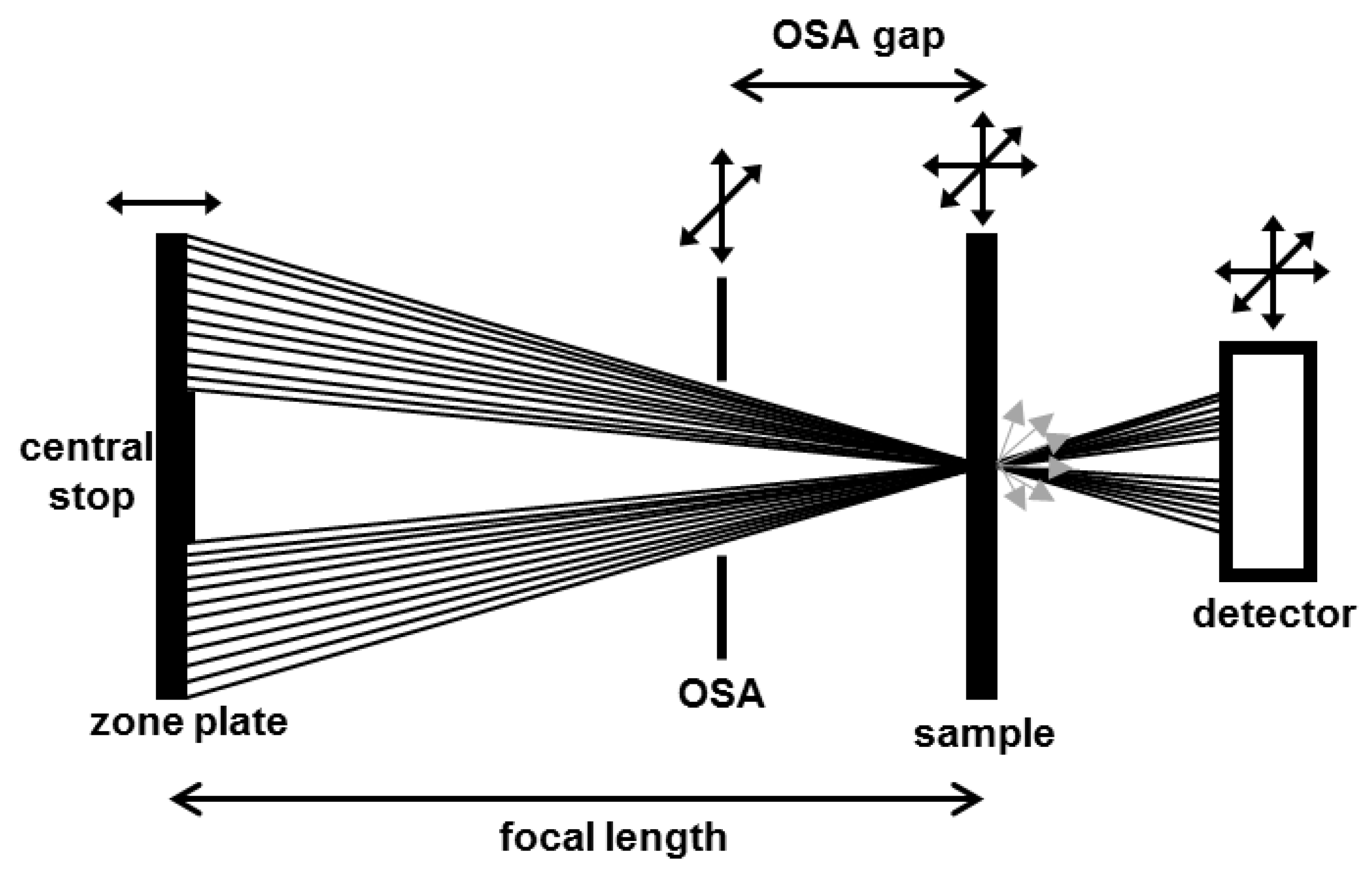
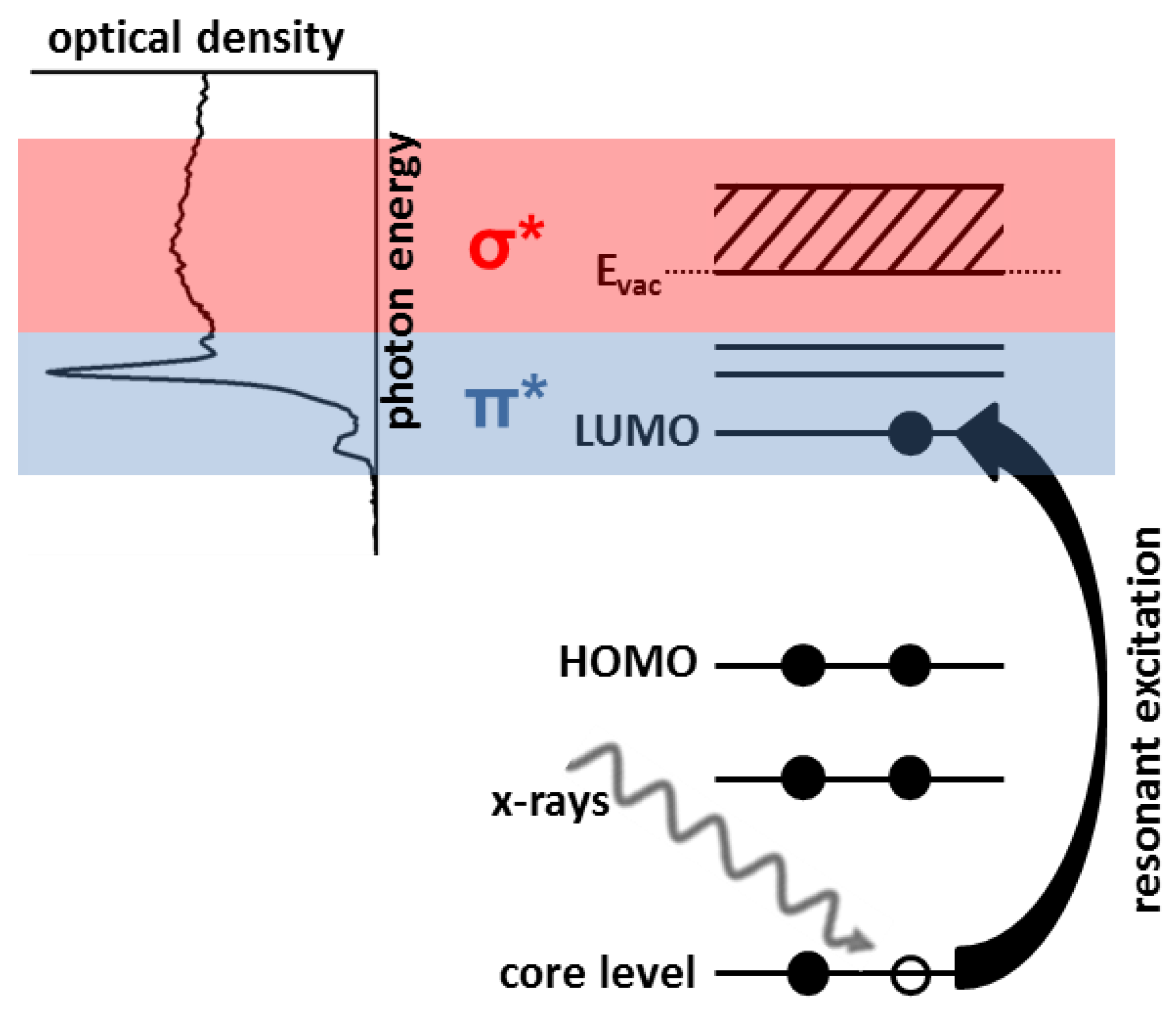
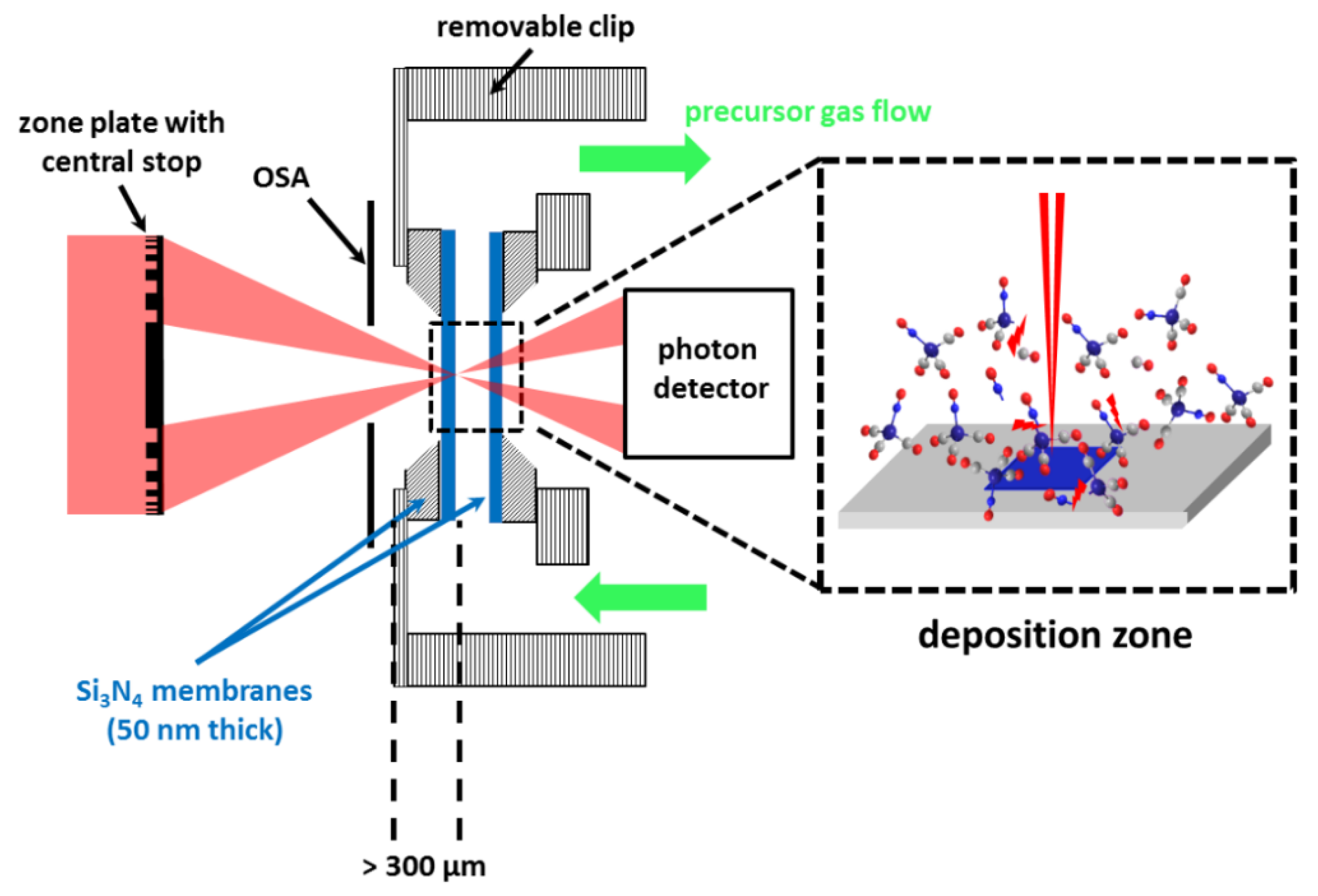
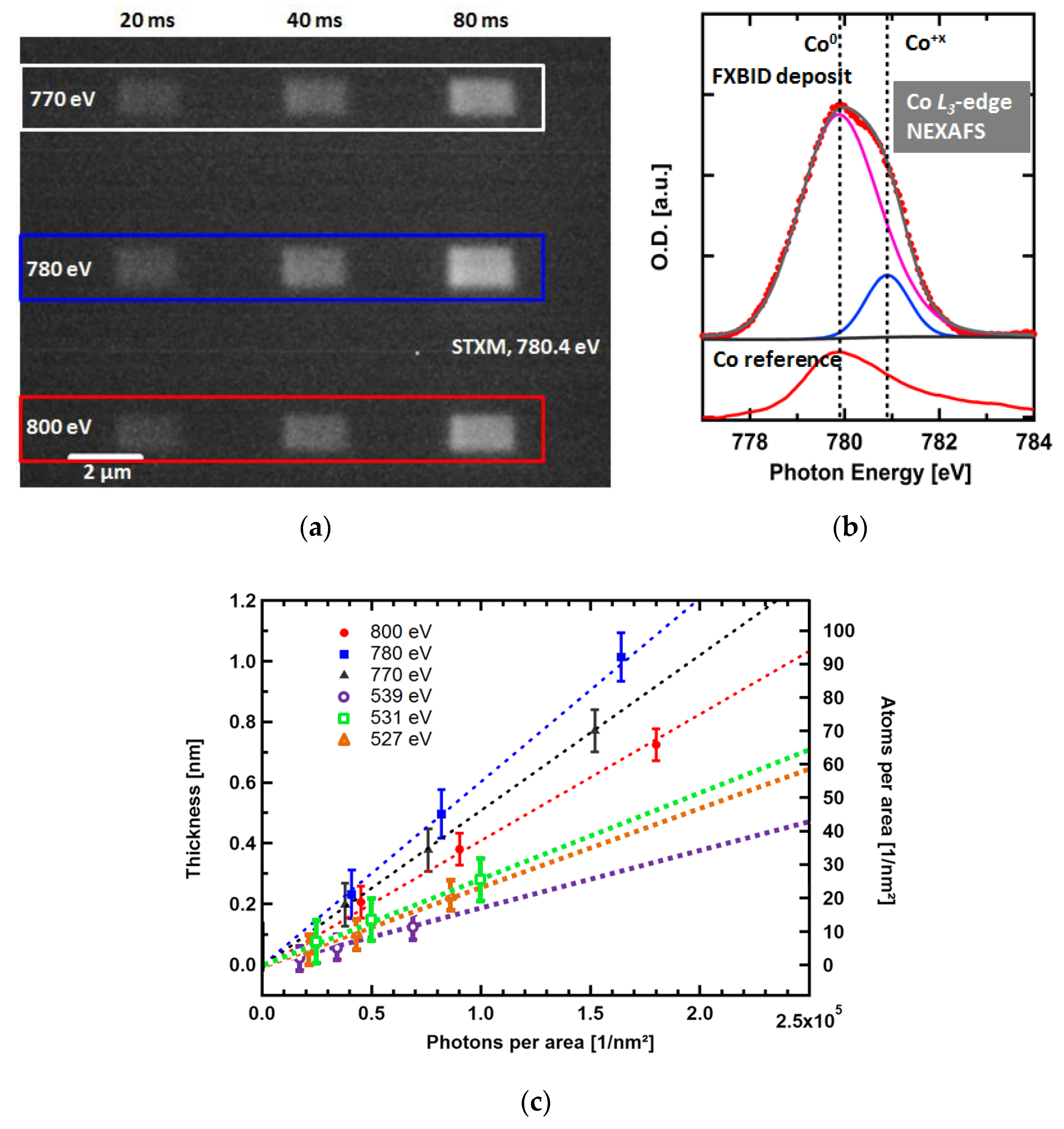
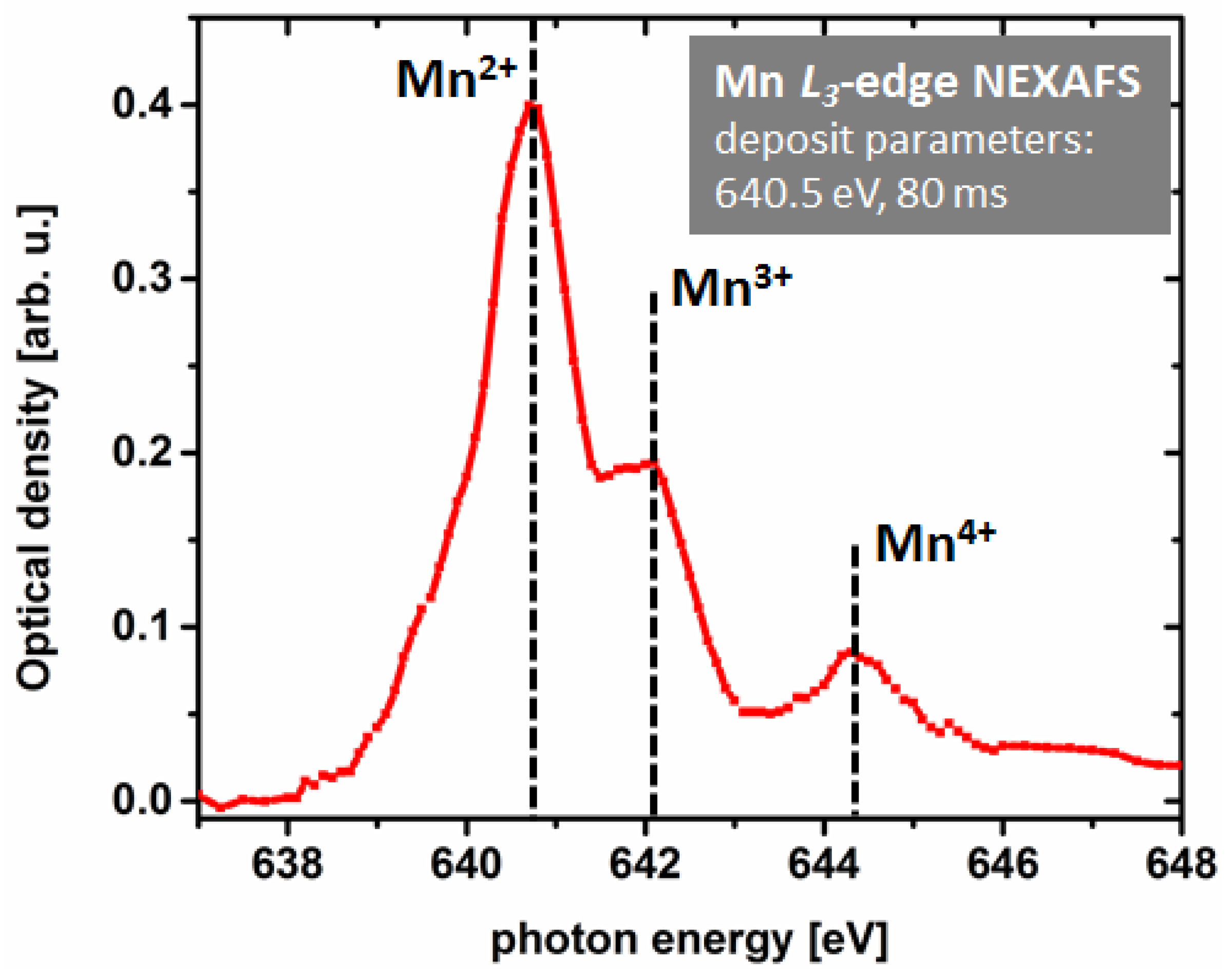
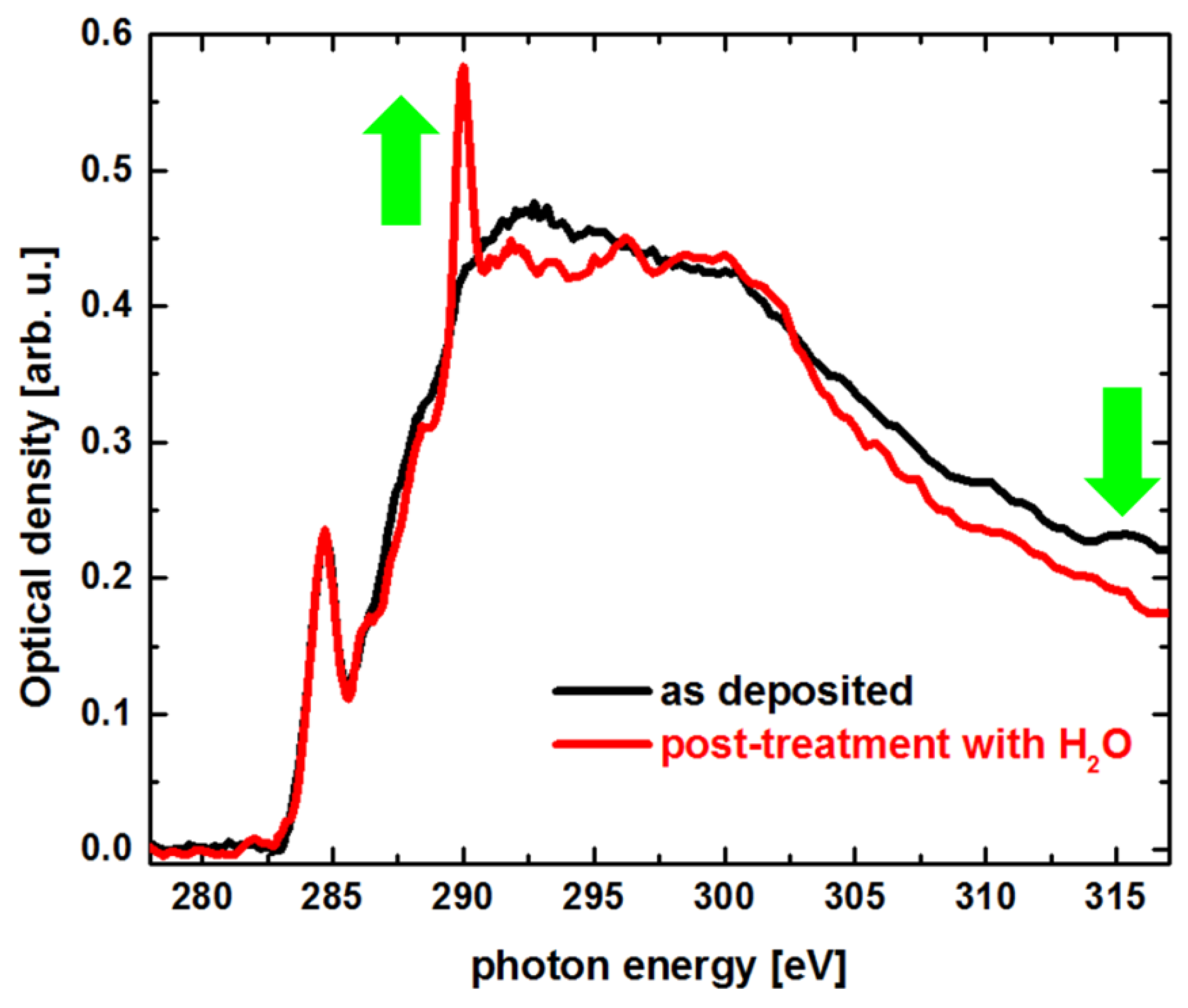
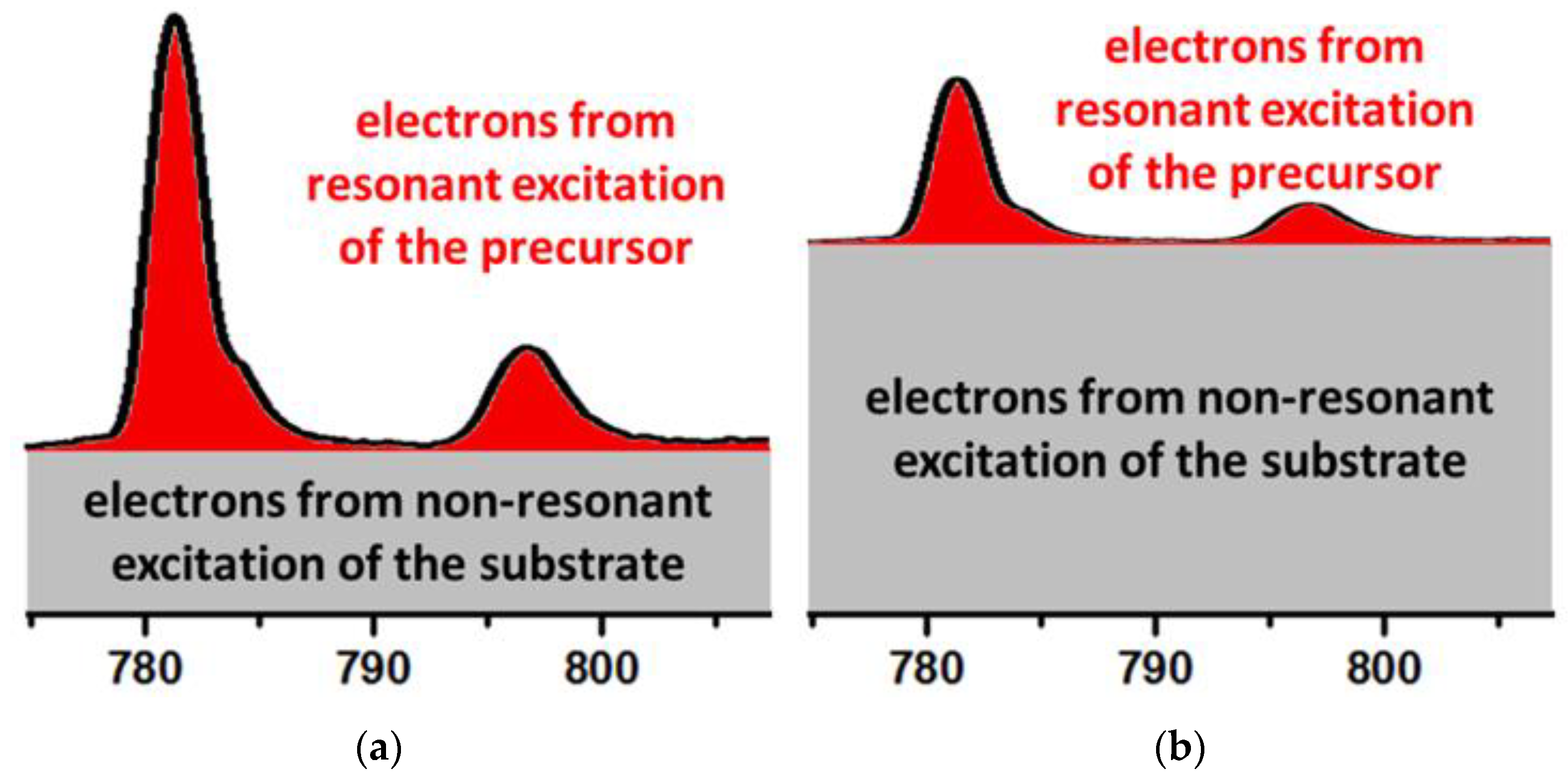
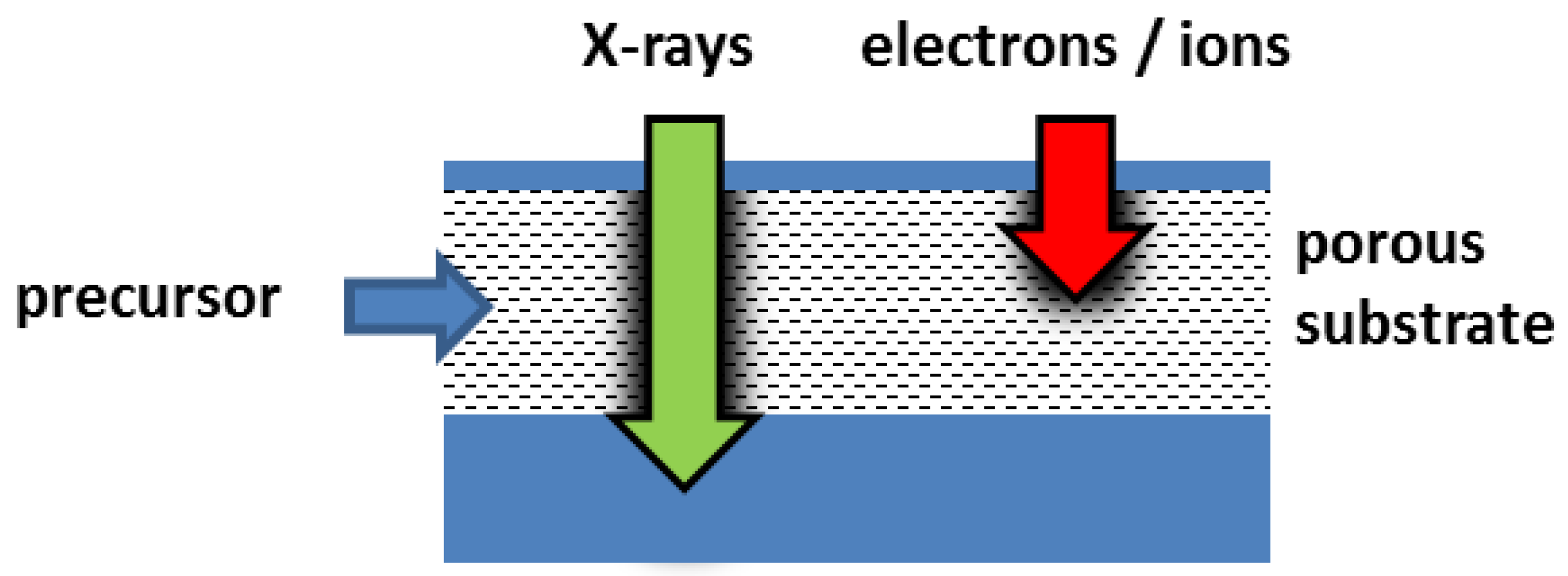
© 2019 by the author. Licensee MDPI, Basel, Switzerland. This article is an open access article distributed under the terms and conditions of the Creative Commons Attribution (CC BY) license (http://creativecommons.org/licenses/by/4.0/).
Share and Cite
Späth, A. Additive Nano-Lithography with Focused Soft X-rays: Basics, Challenges, and Opportunities. Micromachines 2019, 10, 834. https://doi.org/10.3390/mi10120834
Späth A. Additive Nano-Lithography with Focused Soft X-rays: Basics, Challenges, and Opportunities. Micromachines. 2019; 10(12):834. https://doi.org/10.3390/mi10120834
Chicago/Turabian StyleSpäth, Andreas. 2019. "Additive Nano-Lithography with Focused Soft X-rays: Basics, Challenges, and Opportunities" Micromachines 10, no. 12: 834. https://doi.org/10.3390/mi10120834
APA StyleSpäth, A. (2019). Additive Nano-Lithography with Focused Soft X-rays: Basics, Challenges, and Opportunities. Micromachines, 10(12), 834. https://doi.org/10.3390/mi10120834



